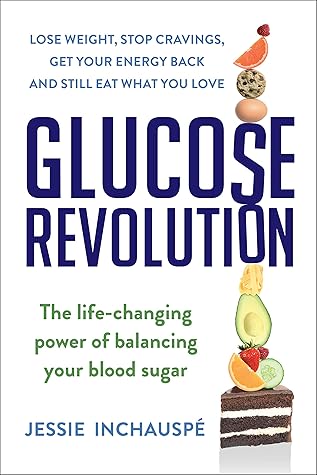More on this book
Community
Kindle Notes & Highlights
Read between
May 14 - May 26, 2023
processed foods and sugar are inherently bad for us,
Glucose is our body’s main source of energy.
Regulating glucose is important for everyone, diabetes or no diabetes:
The flatter our glucose curves, the better.
With flatter glucose curves, we reduce the amount of insulin—a hormone released in response to glucose—in our body,
“Nothing matters—not school, not work, not money—nothing matters more than being healthy, physically and mentally.”
We know how we want to feel. We want to wake up with a smile, feeling energized and excited for the day.
12 percent of Americans are metabolically healthy,
(Waist size is better for predicting underlying disease than BMI
Glucose isn’t everything. There are other factors that determine our health: sleep, stress, exercise, emotional connection, medical care, and more.
pay attention to fat, to fructose, and to insulin, too.
High-fiber pasta is “good” compared to regular pasta but “bad” compared to veggies.
An oatmeal cookie is “bad” in relation to almonds but “good” in relation to a can of Coca-Cola.
10 minutes of moderate physical activity after a meal reduces the glucose spike of that meal.
walking after any meal reduces the glucose spike of that meal.
How Plants Create Glucose
photosynthesis: the process of turning carbon dioxide and water into glucose using the energy of the sun.
Beets, potatoes, carrots, celeriac, parsnips, turnips, jicama, and yams are all roots, and all contain starch.
Rice, oatmeal, corn, wheat, barley, beans, peas, lentils, soybeans, and chickpeas are all seeds, and all of them contain starch,
extra-sweet molecule called fructose, which is about 2.3 times as sweet as glucose.
Plants concentrate fructose into fruit—apples, cherries, kiwis,
The purpose of fructose is to make fruit taste irresi...
This highlight has been truncated due to consecutive passage length restrictions.
Sucrose exists to help plants compress energy even further
fiber is an essential part of our diet and plays a very important role in aiding digestion, maintaining healthy bowel movements, keeping our microbiome healthy, and more.
Why carbohydrates? Because it refers to things that were made by joining carbon (carbo) and water (hydrate), which is what happens during photosynthesis.
Carbohydrates = Starch and Fiber and Sugars (glucose, fructose, sucrose)
broccoli contains a lot of fiber and some starch, potatoes contain a lot of starch and some fiber,
“Broccoli contains a lot of carbs, most of which are fiber.”
when glucose is limited, many cells in our body can, when needed, switch to using fat for fuel instead.
fiber is often removed in the creation of processed foods, because its presence is problematic if you’re trying to preserve things for a long time.
American Diabetes Association (ADA) states that a baseline concentration (also known as your fasting level, that is, your glucose level first thing in the morning before eating) between 60 and 100 mg/dL is “normal”;
between 100 and 126 mg/dL indicates prediabetes; and anything above 126 mg/dL indicates diabetes.
thriving range for fasting glucose may be between 72 and 85 mg/dL.
ADA states that our glucose levels shouldn’t increase above 140 mg/dL after eating.
strive to avoid increasing our glucose levels by more than 30 mg/dL after eating.
glucose spike as an increase in glucose in our body of more than 30 mg/dL after eating.
goal is to avoid spikes, whatever your fasting level is, because it’s the variability caused by spi...
This highlight has been truncated due to consecutive passage length restrictions.
I advise you to flatten your glucose curves, which means zooming out and seeing fewer and smaller spikes over time.
flattening your glucose curves is reducing glycemic variability.
Free radicals are a big deal because anything they touch, they damage.
Oxidative stress is a driver of heart disease, type 2 diabetes, cognitive decline, and general aging.
Too much fat can also increase oxidative stress.
even though we’re fueling up by eating, we suffer from lassitude; it’s hard to get up in the morning, and we have no energy throughout the day.
We’re tired. Do you know the feeling? I sure did.
hemoglobin A1c (HbA1c) test (well known among diabetics) measures how many red blood cell proteins have been glycated by glucose over the past two to three months.
The combination of too many free radicals, oxidative stress, and glycation leads to a generalized state of inflammation in the body.
World Health Organization calls inflammation-based diseases “the greatest threat to human health.”
Insulin’s sole purpose is to stash excess glucose in storage units throughout the body, to keep it out of circulation and protect us from damage.
Once insulin has stored all the glucose it can in our liver and muscles, any glucose beyond that is turned into fat and stored in our fat reserves.
only thing that fructose can be stored as is fat.


